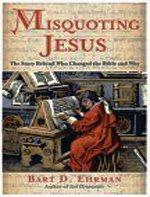

Book title: MISQUOTING JESUS: The story behind who changed the Bible and why
by Bart D. Ehrman
San Francisco: HarperCollins Publishers; 2005
242 pages; cloth; 24.95
Today’s cultural trends make it popular to be a Bible-basher. While we cannot know an author’s motives beyond question, Misquoting Jesus appears to be written with an agenda to evoke doubt as to the authenticity and authority of Scripture. Bart Ehrman, an expert on biblical texts who has published several books on textual criticism, writes in a warm and readable style. His other works, however, have seemingly served as teasers in anticipation of this book. He confesses that this is what he has wanted to say about the Bible all along. Admitting that he has undergone a metamorphosis in his view of Scripture, he candidly states that he sees the Bible as “a very human book from beginning to end.” It is now easy to understand his goal of helping the rest of us to view the Bible as an uninspired mishmash “written by human authors at different times and in different places to address different needs.” One wonders: then why bother? Without inspired Scriptures we humans are nothing more than robots of destiny and fate, without hope in the world—lemmings on our march to the sea of nothingness. Ehrman’s penchant for quoting Celsus, a late second century critic of the Bible and Christianity, suggests a closer alignment with his views than with the Christian writers of that era, and perhaps even the biblical writers themselves. Overall, he does not seem to be writing to scholars but to lay readers who can easily be impressed by his assumptions drawn from unnamed manuscripts.
Technically, much of what Ehrman points out about biblical manuscripts is not new. Textual critics have struggled for centuries with many of the same texts on which he focuses. For example, he suggests that Mark made a “mistake” when he wrote that David ate the showbread of the Tabernacle “in the days of Abiathar the high priest” (Mark 2:26). He points out that I Samuel 21:1-6 states that Abiathar’s father Ahimelech was the high priest at that time. It is well known that “in the days of” can mean during the lifetime. The biblical record reveals that Ahimelech died shortly after this event (I Samuel 22:19,20) and Mark added this designation to identify the well-known companion of David who succeeded his father as high priest, along with Zadok (II Samuel 15:35). This perceived “mistake” by Mark opened the floodgates of doubt for Ehrman. He began to find other “errors” of Scripture, such as the mustard seed being the smallest of seeds in the world (Mark 4:31). Since that time smaller seeds have been found to exist, but it was the smallest in comparison to all the other seeds sown in Palestine. Ehrman began to feel that such “mistakes” indicated that others, perhaps bigger and more important ones, were also in the Holy Writ. He has made the search for them his life’s work.
The obvious target of the author is the divinity of Jesus, which of course could be easily set aside if Scripture were proved unreliable. Ehrman tries hard to discredit this cardinal doctrine of the Christian faith. One reference cited is Acts 20:28, which speaks of “the church of God, which he hath purchased with his own blood.” He posits that since the fifth century Codex Alexandrinus manuscript (and a few other less notables) has “Lord” rather than “God,” it is not a usable text to demonstrate the deity of Jesus. As some other scholars do, he eschews the translation of “God” in I Timothy 3:16, preferring “he.” The subject in context is God, so it changes nothing of a doctrinal nature. Ehrman’s Socinian leanings seem quite evident.
The author feels it is immensely important to determine whether the text of Mark 1:41 shows that Jesus was angry or compassionate, whether He was calm or in deep distress in Luke 22:43,44, and if Hebrews 2:9 suggests that Christ died by God’s grace or “apart from God.” Those passages contain textual variants, but they change no fundamental doctrine. He points out differences in style here and there, such as in the Gospel of John. Too many positions on the sacred text are taken based on assumptions—“it appears...we can surmise...we assume...we can expect....” His deductive arguments are wearying, such as his treatment of the role of women in Scripture. He is obviously as fond of pseudepigrapha as he is of the accepted canon itself. We should be glad that the Gospel According to Judas did not appear on the scene before this book was published or he might be trying to convince us that Judas was Jesus’ best friend to the end.
To Ehrman’s credit he is correct on many of his assessments of manuscript changes and interpolations. But why rehash over and over that the story of the woman taken in adultery and the long ending of Mark do not appear in what experts consider the oldest and best manuscripts, or that I John 5:7,8 contains a scribal addition to delineate the doctrine of the Trinity, or that “and fasting” was probably added later to Mark 9:29? That is fairly common knowledge. Copies of copies of copies made by an over-zealous scribe or a sleepy monk working in the dim light of some ancient monastery usually lacked perfection. But it is significant that these examples do not negatively affect any apostolic doctrine, although they do reveal the weakness of the Trinitarian position, as in the case of I John 5:7,8. At the bottom line, Ehrman has not shown us why we should distrust the Bible on its history or geography, but he has given us more reason to distrust those who handle it deceitfully (II Corinthians 4:2). He has stretched the limits of credibility, not for the Bible but for the skeptics, although scoffers will surely quote him.
“Heaven and [Bart] shall pass away, but my words shall never pass away” (Jesus, Luke 21:33).
J. R. Ensey
 Bio: J.R. Ensey is a former president of Texas Bible College, having served in that capacity for fourteen years (1982-1996). Prior to that time, he founded a church in North Carolina and served the General Home Missions Division of the United Pentecostal Church International in various capacities for eight years. Subsequent pastorates were held in Texarkana, Arkansas, and Wichita Falls, Texas. He is the founding editor of two denominational magazines and the author of fifteen books, including The Pastoral Epistles, Letters From a Roman Jail, and many booklets, tracts, and articles. He holds degrees in Theology and Business Administration and currently directs the extension campus program for Texas Bible College. You can go to Ensey's website and bookstore by clicking here.
Bio: J.R. Ensey is a former president of Texas Bible College, having served in that capacity for fourteen years (1982-1996). Prior to that time, he founded a church in North Carolina and served the General Home Missions Division of the United Pentecostal Church International in various capacities for eight years. Subsequent pastorates were held in Texarkana, Arkansas, and Wichita Falls, Texas. He is the founding editor of two denominational magazines and the author of fifteen books, including The Pastoral Epistles, Letters From a Roman Jail, and many booklets, tracts, and articles. He holds degrees in Theology and Business Administration and currently directs the extension campus program for Texas Bible College. You can go to Ensey's website and bookstore by clicking here.
No comments:
Post a Comment